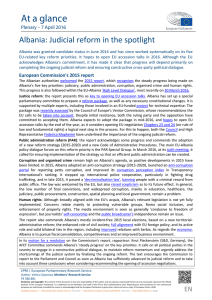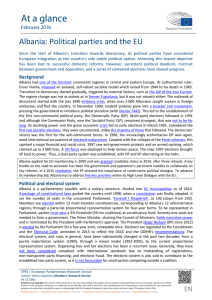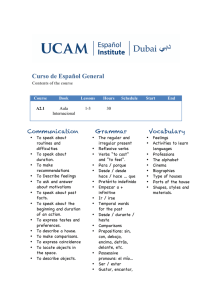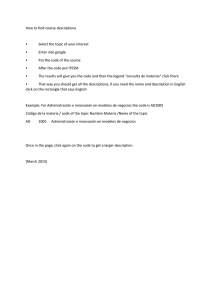l la rest truct a uració albania ón de la: des la adm de pla ministr an
Anuncio
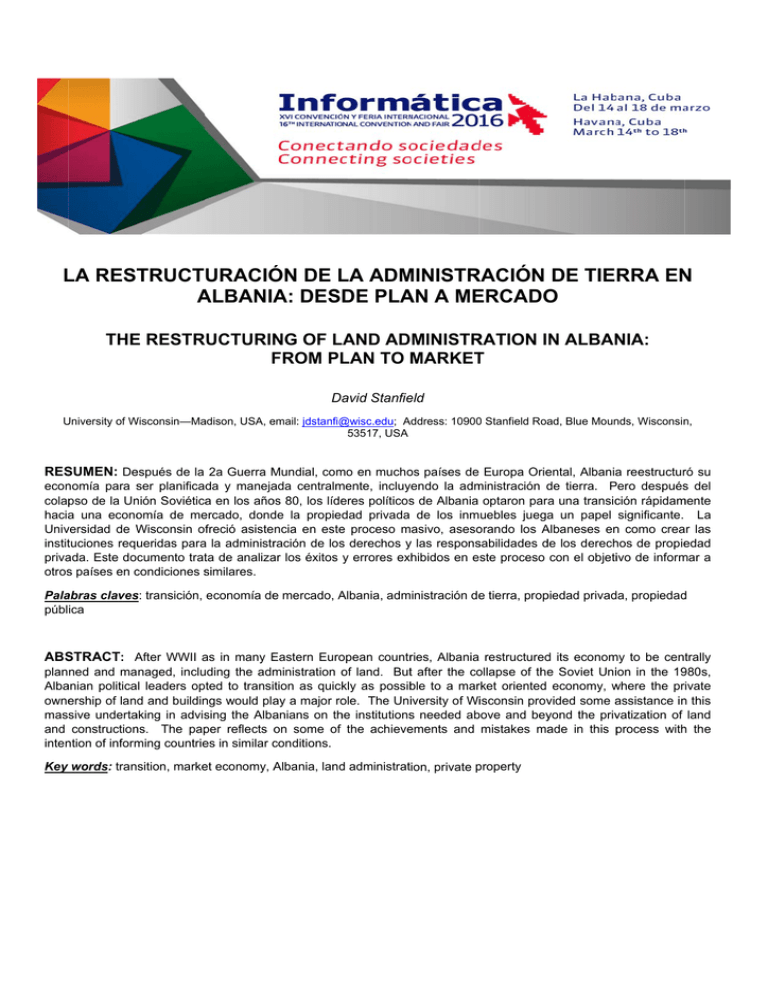
L LA REST TRUCTURACIÓ ÓN DE L LA ADM MINISTR RACIÓN DE TIERRA EN N A ALBANIA A: DESDE PLA AN A ME ERCADO O THE E RESTRUCTURIN NG OF LAND ADMINISTR RATION IN ALBAN NIA: F FROM PL LAN TO MARKET M T Da avid Stanfie eld U University of W Wisconsin—Ma adison, USA, e email: jdstanfi@ @wisc.edu; Address: 10900 0 Stanfield Roa ad, Blue Moun nds, Wisconsin n, 53517, USA RES SUMEN: De espués de la 2a Guerra M Mundial, com mo en mucho os países de Europa Orie ental, Albania a reestructurró su econ nomía para sser planificad da y maneja ada centralm mente, incluyendo la adm ministración de d tierra. Pero P despuéss del colap pso de la Un nión Soviética a en los año os 80, los líde eres políticoss de Albania optaron para una transicción rápidam mente hacia a una econo omía de me ercado, dond de la propied dad privada de los inmuebles juega a un papel significante. La Univversidad de Wisconsin W offreció asistencia en este e proceso masivo, aseso orando los A Albaneses en n como crea ar las instittuciones requ ueridas para a la administrración de loss derechos y las responssabilidades d de los derech hos de propie edad priva ada. Este documento tratta de analiza ar los éxitos y errores exhibidos en este proceso con el objetiivo de inform mar a otross países en ccondiciones ssimilares. Pala abras claves s: transición, economía de e mercado, Albania, A administración de e tierra, prop piedad privad da, propiedad d pública ABS STRACT: A After WWII a as in many E Eastern Euro opean countrries, Albania restructured d its econom my to be centrally planned and ma anaged, inclu uding the adm ministration of o land. Butt after the co ollapse of the e Soviet Uniion in the 19 980s, Alba anian political leaders opted to transition as quickkly as possib ble to a marrket oriented economy, w where the private owne ership of land and buildin ngs would pla ay a major ro ole. The Uniiversity of Wiisconsin provvided some assistance a in n this massive underta aking in advissing the Alba anians on th he institutionss needed ab bove and beyyond the privvatization of land and construction ns. The pap per reflects o on some of the achieve ements and mistakes ma ade in this p process with h the inten ntion of inform ming countrie es in similar cconditions. Key words: transition, marke et economy, A Albania, land d administration, private property p David Stanfield | LA RESTRUCTURACIÓN DE LA ADMINISTRACIÓN DE TIERRA EN ALBANIA: DESDE PLAN A MERCADO 1. INTRODUCTION The objective of this paper is to describe briefly the experiences of the Land Tenure Center, University of Wisconsin-Madison with improving land administration in Albania as the country transitioned from a command economy to a market oriented one. Perhaps other countries in similar transition conditions can benefit from the Albanian experiences. The recent history of Albania demonstrates some of the challenges for countries moving from a planned economy with State ownership of most real property and minimal private transactions in real property, to a mixed economy where real property ownership is widespread and where markets function actively within an institutional framework for encouraging environmental and social sustainability. Albania is a relatively small country with a land area of 28.748 sq km (about 11.000 sq miles) located on the Adriatic Sea in SE Europe on the northern border of Greece. Total population in 1990 was about 3.2 million of which about 40% lived in urban areas (1). After the trauma of WWII, Albania became part of the socialist block of Eastern European countries, and gradually eliminated private property as solidified in its Constitution of 1975. Most of Albania’s agricultural land by 1975 was organized into cooperatives from the expropriation of large estates and the collectivization of small holdings. In urban areas the State expropriated the homes of the wealthier classes and gradually all commercial and industrial enterprises. The workers in the cooperatives, state farms, and commercial and industrial enterprises as well as in public services (schools, hospitals, water, electric, telephone, etc) were State or State enterprise employees. The State invested in the consolidation of agricultural enterprises as well as in commercial and industrial enterprises and their technological evolution. The State also constructed apartment buildings mostly using volunteer labor who then were awarded apartments for their use. The country’s economy functioned largely as a single enterprise, centrally planned and managed, in a world of threats and insecurities. While allied with Yugoslavia and the Soviet Union following WWII, Albania linked with China for several years. Fears of invasion led to the construction of a network of concrete pillboxes along the coast and along the country’s border with Greece. 2. CRISIS IN EASTERN COMES TO ALBANIA EUROPE As the dissolution of the Soviet Union unfolded in the late 1980s, the events in Eastern Europe had great influence on Albania. The turmoil in Romania in the late 1980s resulted in the violent overthrow of Ceauşescu and the end of the Communist regime in that country in 1989 and a period of extreme social instability. The Albanians experienced similar instability in the early 1990s but the heirs of the Hoxha regime in Albania (Enver Hoxha died in 1985) wanted to avoid the Romanian violence by providing land to the people on a massive and emergency basis. The economy based on state enterprises had largely collapsed, masses of people were leaving the country as fast as they could, and the spector of starvation threatened the country. The first emergency economic measure was the Law on Land approved by Parliament in July 1991, which authorized the distribution of agricultural land then organized into cooperatives to the workers on those farms in family owned parcels, but with possessory rights and not the right to sell. The March 1992 elections saw the formation of two parties more or less agreed to the transition of Albania to what they understood as a market economy, with some differences as to degree and speed of this transition. The Law on Land of 1991 distributed State assets, agricultural land, to the families of workers on agricultural cooperatives. This basic principle was rapidly applied to other State assets—particularly state farms, apartment buildings, and even artist studios as well as commercial entities such as restaurants, although most enterprises simply closed, in some instances for years. IX CONGRESO INTERNACIONAL GEOMÁTICA 2016 David Stanfield | LA RESTRUCTURACIÓN DE LA ADMINISTRACIÓN DE TIERRA EN ALBANIA: DESDE PLAN A MERCADO 3. ASSISTANCE BY THE UNIVERSITY OF WISCONSIN FOR DEVELOPMENT OF ALBANIAN LAND ADMINISTRATION The US reopened its embassy in Tirana in 1991. In May, 1992 the US Agency for International Development invited a team from the University of Wisconsin’s Land Tenure Center to do an assessment (2) of the land reform efforts launched by the Law on Land of July, 1991. That study resulted in USAID’s challenge to the University to provide practical assistance to Albania for the transition to a market oriented economy, composed of private and public rights to property and the institutions needed for protecting those rights and defining the associated responsibilities. In February, 1994 the UW agreed to accept the USAID challenge, resulting in an eight year University program supporting the development and implementation of the Albanian Land Market Action Plan, involving USAID, World Bank and EU financial and technical support. The Land Market Action Plan was approved by Cabinet (an executive body including all Ministers) in 1993 Since February 1993 along with a Coordinative Working Group with representatives from the five Ministries relevant to a property registration system to implement the Action Plan (Agriculture and Food, Justice, Construction, Finance and Defense). The main challenges faced in that Action Plan in 1994 were: Western countries’ pressures on the countries in the Soviet block and the tremendous sense of crisis plaguing these countries had pushed the privatization of land and industries as the key to unlocking the magic of the market economy and achieving the economic levels of the western European countries. The Albanians had done a major privatization of agricultural land with the Law on Land of 1991, but had no conception that a market oriented economy requires a complex web of supporting and guiding institutions which did not exist. Institutional capacities had to be created for such functions as: • • • • • • • • Registration of private and public rights to Immovable property and mapping of property boundaries Planning for development of land and other resources in urbanizing areas Assessing the monetary values of properties Assisting buyers and sellers of rights to land and buildings to complete transactions legally Protection of environmentally threatened lands, water, forests Regulation of expanding informal urban settlements through informal land markets Financing of investments using immovable properties as collateral (mortgaged lending) Management of conflicts over private and public properties 4. INSTITUTIONAL DEVELOPMENT FOR REGISTRATION OF RIGHTS AND OTHER LAND ADMINISTRATION FUNCTIONS (3, 4) Given the massive privatization of land which was begun in 1991 focusing on agricultural land, the immediate need was for an institution to record the rights to immovable properties and register the subsequent transfers of those rights as normally occurs in market oriented economies. The government in the early 1990s launched many other privatization programs, but each with different concepts of “owner” holding the privatized rights as well as what public entities would exercise the rights to real property which was not privatized: • The privatization of rights to agricultural land under the Law on Land of 1991 was not to individuals, but to over a half million families; • apartments were privatized in joint ownership of occupants through a law approved in 1992 affecting over 1 million IX CONGRESO INTERNACIONAL GEOMÁTICA 2016 David Stanfield | LA RESTRUCTURACIÓN DE LA ADMINISTRACIÓN DE TIERRA EN ALBANIA: DESDE PLAN A MERCADO • • • • apartments and businesses in State constructed multiunit buildings artists’ studios were awarded to the individual artists; buildings used for state businesses were sold at very favorable rates to mostly local buyers or were simply abandoned, and later torn down or remodeled and repurposed; road rights of way, schools, hospitals, and other public buildings were left de facto in State or municipal ownership; forest tenure forms evolved into communities holding use rights. This situation of rampant privatization required the immediate crafting of legislation defining the rules and procedures for the administration of private and public right to immovable properties adapted to the variety of ownership types that emerged. The law on Immovable Property Registration (No. 7843) was approved by Parliament in July of 1994. While the Registration law was being debated, field teams were testing procedures for surveying the boundaries of the new family owned agricultural land parcels and for recording the names of the families to whom the Village Land Commissions had assigned each privatized parcel. The field teams used the privatization documents produced by Village Land Commissions, and the various parcel maps sketched by the District Cadastral officers onto existing paper base maps which had been produced by the Ministry of Agriculture for the management of agricultural cooperatives and State Farms. New parcel maps and lists of family owners were produced and put on display for a month in each Village for correction and for educating the villagers about how the new Registration Offices operated. Due to the high village populations and the strong egalitarian tendencies of the village land commissions, the agricultural land was distributed to farm families in the form of multiple family owned small and fragmented parcels. Also, in many villages there were disputes as to the right of owners prior to the collectivization programs had eliminated all private ownership of land as finalized in the Constitution of 1975. The Village Commissions tended to divide the agricultural land among the existing workers, without strictly observing their land holdings prior to the collectivization programs of the 1950s. But these claims were still in the minds of the people, and led to de facto re-distributions of ag land in some villages or simply lingering bad feelings in others. Beginning in 1993 procedures were also piloted for registering and mapping the joint ownership of apartments and retail stores. With the approval of the Land Registration law in 1994, there was a pressing need not only for the initial registration of privatized agricultural land and privatized apartments, but also for the building and furnishing of Registration Offices, and the training and monitoring of staff. This establishment of Registration Offices and the initial registration of private and public properties came at a time of great frenzy for acquiring private property rights. There was also a gradually emerging need for the registration of new owners resulting from transactions of private rights from one owner to another and for establishing the institutional bases for protecting the public interests in the emerging private property system. Initial registration of a property involved the definition of the boundaries of the property and the determination of the owner(s), both aspects basic for creating a title registration system. Title registration is favored in many European countries and in most ex British colonies as distinct from a deeds based registration system favored in most US States and countries influenced by the Spanish and French legal traditions. A main component of the Land Market Action Plan was the systematic first registration of all properties in each former cooperative and state farm as well as in entire apartment buildings, including residential and commercial units within them. The recording of rights and description of boundaries were done within one institution— the Immovable Property Registration System. No separate cadaster was created for mapping property boundaries. Private companies were contracted to do the property boundary IX CONGRESO INTERNACIONAL GEOMÁTICA 2016 David Stanfield | LA RESTRUCTURACIÓN DE LA ADMINISTRACIÓN DE TIERRA EN ALBANIA: DESDE PLAN A MERCADO mapping and the assembling of evidence of ownership rights to the mapped properties as well as the display of the maps and registries for comment and correction, and finally the digitization of the registries and maps. The 2.3 million property records produced from the first registration process during the period 2004-2001 were transferred to all 34 Registrars and their District Offices throughout the country. There remained to be initially registered approximately 1.7 million properties after the termination of the Action Plan in 2001. The Land Market Action Plan also included components for building land related institutions for the regulation of land markets and for other lnd administration functions. • Capacity development, including graduate studies, study tours and equipment for Albanian University Development Planning Faculties • Formation of Association of Property Assessors and training • Formation of Association of Realtors and their training • Preparation of an Environmental Protection Action Plan. • Development of procedures for initial registration of properties in informal urban settlements. • Preparation of mortgage legislation and regulations for lending institutions • Preparation of legislation for a special land court for handling conflicts over immovable property rights and boundaries 5. LESSONS LEARNED The Land Market Action plan was constantly evolving in the chaotic environment post 1992 through its abandonment in 2002. While there were impressive achievements, looking back there are also some things which could have been done differently and better: a. Private rights property were extinguished legally in 1975 and all deeds based Registry offices closed. By 1996 the Albanian Parliament had approved legislation for the massive privatization of rural and urban immovable properties and for the creation of a new Immovable Property Registration system. Donors and government partnered beginning in 1995 for initial registration of over 2 million new properties and the building of new institutions for guiding the new markets in immovable properties. However,many judges and lawyers in 2000 remembered the old system which described properties in metes and bounds and not property maps. When the new title registration system was transferred to the control of the Ministry of Justice and all the staff in the new registration offices were replaced by political appointees in 2004, old ways for conducting transaction emerged focused on legal procedures. Cadastral Index Maps describing property boundaries were not updated, and property boundary descriptions evolved into verbal metes and bounds. There were no politically powerful champions for the IPRS. b. While initial registration of privatized property rights was based on documentations of the results of privatization commissions, committees and other entities, the Land Market Action Plan did not envision the involvement of community elders and members in this process, other than community viewing and correcting the property maps and lists of adjudicated owners. A much more ambitious public education and mobilization effort was called for to accomplish an initial registration which would be viewed as legitimate by the population and whose value was understood by the general public. c. Significant pockets of resistance existed to the privatization of rights to lands and buildings to their possessors rather than the restitution of properties to their owners prior to the Hoxha collectivization and expropriation of private owners after WWII. IX CONGRESO INTERNACIONAL GEOMÁTICA 2016 David Stanfield | LA RESTRUCTURACIÓN DE LA ADMINISTRACIÓN DE TIERRA EN ALBANIA: DESDE PLAN A MERCADO This pressure for the restitution of properties to their pre-1948 owners continues 20 years after the decisions were made to form a market oriented economy where private rights to property would play a major role. Whose private rights are legitimate is a discussion which goes on. The initial registration effort might have included provisions for “provisional” first registration and special adjudication courts created in communities and buildings where former owners exercised substantial influence. d. Market Oriented Economy and Corruption There was a gradually emergence of an awareness that “greed is good” in a market oriented economy, That is, most Albanians in the 1990s came to believe that people “should” maximize their individual gains without social obligations. Many Albanians gravitated to such ideas after several decades of restricting opportunities for consumerism imposed by a socialist regime under threat, real and perceived, committed to self-sufficiency, economic and political within a command economy. Western market oriented economies had developed restraints on such impulses over many centuries, some with greater success than others. But in Albania few such restraints remained after the fall of the communist regime. Western countries preached the need for reducing corruption, but seemed to focus more on governmental corruption rather than its private business counterpart. Rampant corruption in western country elections, especially in the US, also undermined their anti-corruption sermons to the Albanians. Unrestrained greed became the mantra of the day in Albania as in most of the planet. Perhaps the combination of ecological and economic crises in recent years over most of the earth will produce a movement for protecting the “common good” (5) which would benefit also those Albanians who struggle for such an aim. 6. ACKNOWLEDGEMENTS From our first meetings in chaotic Tirana in 1992, the core team of Ahmet Jazoj, Spiro Lamani, Romeo Sherko, Maksi Raco, Mira Laha, Norman Singer and David Stanfield expanded to include Mark Marquardt, Kathrine Kelm, Albert Dubali, Rachel Wheeler, Malcolm Childress, Edmond Leka and hundreds of staff and consultants. This group of dedicated professionals helped to establish the institutional foundations for a socially and environmentally sustainable market oriented mixed economy. References 1. Information Provided by the Government of Albania to the United Nations Commission on Sustainable Development, Fifth Session, 7-25 April 1997, New York 2. David Stanfield, John Bruce, Susana Lastarria-Cornhiel, and Edward Friedman, “Consolidating Property Rights in Albania’s New Private Farm Sector”, LTC Paper 146, December, 1992 3. David Stanfield and Sonila Jazoj, May, 2008, “The Evolution of Immovable Property Registration in Albania”, paper presented to the International Conference on Real Estate Development in Albania, Tirana International Hotel. 4. Ontario Law Reform Commission. “Report on land registration”, Ontario Department of Justice, 1971. 5. Pope Francis, 2015, “Encyclical Letter Laudato Si on Care for Our Common Home”, Vatican, Rome Summary of author’s background The author has an undergraduate degree in Mathematics from Ohio State University, a Master’s degree in International Relations and Organization from American University in Washington, D.C., and a PhD in Communication from Michigan State IX CONGRESO INTERNACIONAL GEOMÁTICA 2016 David Stanfield | LA RESTRUCTURACIÓN DE LA ADMINISTRACIÓN DE TIERRA EN ALBANIA: DESDE PLAN A MERCADO University, East Lansing. Since 1978 the author has worked principally through the Land Tenure Center at the University of Wisconsin in Madison, and specialized in the evolution of land tenure institutions in mixed economies characterized by private, communal, indigenous, and public rights to land and buildings. Activities have included teaching, research, training and advising experience on land tenure institutions in South, Central and North America, Eastern Europe, Central and South Asia, and Africa. IX CONGRESO INTERNACIONAL GEOMÁTICA 2016
